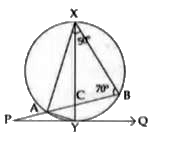In an arithmetic progression of 50 terms, the sum of first ten terms is 210 and the sum of last fifteen terms is 2565. Find the arithmetic progression. Solution in Kannada
The correct Answer is:AP is 3,3+4,3+2(4),….....,3+49(4)
3,7,11,…...199.
Step by step video, text & image solution for In an arithmetic progression of 50 terms, the sum of first ten terms is 210 and the sum of last fifteen terms is 2565. Find the arithmetic progression. by Maths experts to help you in doubts & scoring excellent marks in Class 10 exams.
Updated on:21/07/2023Topper's Solved these Questions
- ARITHMETIC PROGRESSIONSBOOK - ZEN PUBLICATIONCHAPTER - ARITHMETIC PROGRESSIONSEXERCISE - ZEN ADDITIONAL QUESTIONS (HOTS [HIGHER ORDER THINKING SKILLS] - QUESTIONS)
4 Videos
- ARITHMETIC PROGRESSIONSBOOK - ZEN PUBLICATIONCHAPTER - ARITHMETIC PROGRESSIONSEXERCISE - ZEN ADDITIONAL QUESTIONS (SHORT-ANSWER [SA] TYPE 2 - QUESTIONS)
14 Videos
- AREA RELATED TO CIRCLES BOOK - ZEN PUBLICATIONCHAPTER - AREA RELATED TO CIRCLES EXERCISE - ADDITIONAL QUESTIONS (HIGHER ORDER THINKING SKILLS)
7 Videos
- CIRCLESBOOK - ZEN PUBLICATIONCHAPTER - CIRCLESEXERCISE - ZEN ADDITIONAL QUESTIONS ( HOT [HIGHER ORDER THINKING SKILLS] - QUESTIONS) (IIT AND IMO)
9 Videos
Similar Questions
If m times the mth term of an A.P. is equal ton times the nth term and m≠n, show that (m+n)th term is zero.
View SolutionFind the 12th term from the end of AP 8, 10, 12, ..... , 130
View SolutionFind the area of the shaded region portion in the given figure if E is the midpoint of AB,AGE and BEF are quadrants, and DOC is a semicircle.

View SolutionIn the adjoining figure, XY is a diameter of the circle and PQ is a tangent to the circle at Y. Given that ⌊AXB=50∘ and ⌊ABX=70∘, calculate ⌊BAY and ⌊APY.

View SolutionIn a AP of 50 terms the sum of first 10 terms is 210 and the sum of last 15 terms is 2565. Then find the AP
View SolutionThe first term of an arithmetic progression is 1 and the sum of the first nine terms equal to 369. The first and the ninth term of a geometic progression colncide with the first and the ninth term of the arithmetic progression. Find the seventh term of the geometric progression.
View SolutionThe sum of the fourth and twelfth term of an arithmetic progression is 20. What is the sum of the first 15 terms of the arithmetic progression?
View SolutionThe sum o the fourth and eighth terms of arithmetic progression is 24 and the sum of the sixth and tenth terms is 44. Find the first three terms of the Arithmetic progression:
View SolutionIf the sum of the first 100 terms of an arithmetic progression is −1 and the sum of the even terms is 1, then the 100th term of the arithmetic progression is
View SolutionThe sum of first 'n' terms of an arithmetic progression is 210 and sum of its first (n-1) terms is 171. If the first term 3, then write the arithmetic progression.
View SolutionFind the sum of the first 20 terms of the arithmetic progression having the sum of first ten terms as 52 and the sum of the first 15 terms as 77.
View SolutionConsider an arithmetic progression whose first term is a. if the sum of the first ten terms is zero and the sum of next ten terms is −200 then find the value of a.
View SolutionIn an arithmetic progression of 50 terms, the sum of first ten terms is 210 and the sum of last fifteen terms is 2565. Find the arithmetic progression.
View SolutionIn an arithmetic progression of 50 terms, the sum of first ten terms is 210 and the sum of last fifteen terms is 2565. Find the arithmetic progression.
View SolutionThe sum of the fourth and eighth terms of an arithmetic progression is 24 and the sum of the sixth and tenth terms is 44. Find the first three terms of the Arithmetic progression.
View Solution
